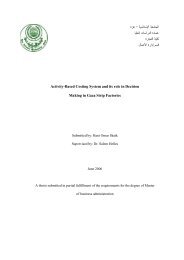A prActicAl guide Benchmarking in european Higher education
A prActicAl guide Benchmarking in european Higher education
A prActicAl guide Benchmarking in european Higher education
Create successful ePaper yourself
Turn your PDF publications into a flip-book with our unique Google optimized e-Paper software.
CONCEPTS AND PRACTICES OF BENCHMARKING<br />
<strong>Benchmark<strong>in</strong>g</strong> <strong>in</strong> the public sector<br />
Our <strong>in</strong>troduction on the history of the term benchmark<strong>in</strong>g already showed<br />
that most applications of benchmark<strong>in</strong>g were developed <strong>in</strong> the private sector<br />
of the economy. Interest<strong>in</strong>g examples can still be found there; it is notable<br />
that benchmark<strong>in</strong>g is possible even <strong>in</strong> the competition of private sector<br />
organisations. As market-like governance mechanisms have become<br />
fashionable <strong>in</strong> the public sector s<strong>in</strong>ce the early 1980s benchmark<strong>in</strong>g has also<br />
entered public-sector organisations. Especially ‘New Public Management’<br />
with its emphasis on (quasi-)markets, strong management, etc., has drawn<br />
attention to <strong>in</strong>struments like quality assurance and benchmark<strong>in</strong>g.<br />
A problem may be that public organisations cannot use profits or similar<br />
widely-known key performance <strong>in</strong>dicators (KPI), which def<strong>in</strong>e a private bus<strong>in</strong>ess’s<br />
success and which are therefore self-evident candidates for benchmarks.<br />
However, even <strong>in</strong> private bus<strong>in</strong>ess, a s<strong>in</strong>gle KPI does not denote a<br />
healthy and prosperous firm: KPIs are always partial. For example, profits<br />
may be pushed at the cost of employee satisfaction. KPIs have to be used <strong>in</strong><br />
balanced sets for management purposes—though for functional benchmark<strong>in</strong>g<br />
(of s<strong>in</strong>gle processes), only one or a few may be needed. In higher <strong>education</strong>,<br />
alternative KPIs to ‘profit’ have been developed. For <strong>in</strong>stance, <strong>education</strong>al<br />
performance can be <strong>in</strong>dicated by retention rates, percentage of students<br />
graduat<strong>in</strong>g on time, student satisfaction, alumni satisfaction, employer<br />
satisfaction, etc. Research and <strong>in</strong>novation performance can be <strong>in</strong>dicated by<br />
numbers of publications, citation scores, number of patents, contract <strong>in</strong>come,<br />
numbers of sp<strong>in</strong>-offs, etc. For services, similar lists can also be found or<br />
developed as well (e.g. library loans, ICT use figures, students back on track<br />
after counsell<strong>in</strong>g).<br />
Yet often <strong>in</strong>dicators are not available, especially not if one wants detailed<br />
<strong>in</strong>formation about processes with<strong>in</strong> organisations show<strong>in</strong>g how performances<br />
are reached. This makes it impossible to engage <strong>in</strong> competitive-type<br />
benchmark<strong>in</strong>g, or f<strong>in</strong>d<strong>in</strong>g best-<strong>in</strong>-class benchmark organisations on the<br />
basis of publicly available data.<br />
42 A Practical Guide - <strong>Benchmark<strong>in</strong>g</strong> <strong>in</strong> European <strong>Higher</strong> Education

















